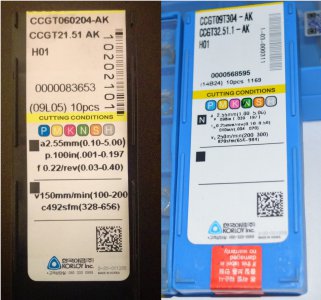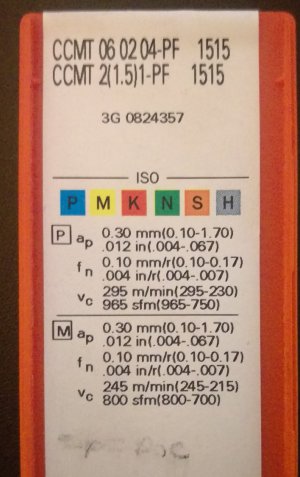- Joined
- Dec 20, 2012
- Messages
- 9,422
I second Dan S.'s suggestion on insert tools - the SCLCR (Right hand) and SCLCL (LH) tools work fairly well. It is unlikely that you will use most of the tools in the Grizzly set. Well, maybe the boring bar. This geometry allows for both facing and turning when the tool is perpendicular to the work and is probably the single most popular tool holder amongst hobby guys. With a max lathe speed of only 1800 rpm, they are not better than a properly ground HSS tool but they do work, especially until you learn to grind tools.
Most 1/2" SCLCR/L tool holders take a 32.5X insert; the Grizz tools take 22.5X inserts. CCMT is the standard insert for these tools but they will accept a CCGT insert, which is sharper at the nose (cornerpoint). The X in 32.5X is the size of the nose radius; this affects your depth of cut and finish. The smaller the number, the smaller the nose radius. Be clear that a tool holder will accept only one size of insert - 32.5X or 22.5X - so you need to know which size insert your tool holder uses. You can use either a CCMT or CCGT insert in these tools.
The CCMT inserts are good for most work and the CCGT-AK inserts work well for aluminum. The AK inserts are very sharp and have a very positive rake so they are very, very good for aluminum. However, be aware that the nose radius can greatly affect the finish in aluminum (and any other material you cut) and a CCGT 32.52 is better than the 32.51 in this regard due to the larger nose radius. AK inserts also work well in softer steels and plastics.
If you need to learn about the differences in the various inserts, I suggest you download and peruse the catalog from Seco or Iscar. Once you know which insert you need you can cross reference it on the Carbide Depot site and either buy it from a supply house or go to ebay, which will be cheaper. Seco, Iscar, Korloy, Kennametal, Valenite/Walter, Mitsubishi are all good brands.
Not all tool holders are created equal regarding the precision of the insert pocket where the inserts sits. One cheap but very good tool holder is made by Tool Mex; they are as good as my Seco and Iscar tool holders at 1/3 the cost. You can find them on ebay. For a 12" lathe, a 1/2" tool should fit and will be much stiffer than a 3/8" tool.
With all that said, these carbide tools are intended for much higher speeds than your lathe can achieve. The geometry and chipbreakers will not be as effective but they will work. When you can, learn to grind a good HSS tool. They will work better in the speed range your lathe can handle.
Most 1/2" SCLCR/L tool holders take a 32.5X insert; the Grizz tools take 22.5X inserts. CCMT is the standard insert for these tools but they will accept a CCGT insert, which is sharper at the nose (cornerpoint). The X in 32.5X is the size of the nose radius; this affects your depth of cut and finish. The smaller the number, the smaller the nose radius. Be clear that a tool holder will accept only one size of insert - 32.5X or 22.5X - so you need to know which size insert your tool holder uses. You can use either a CCMT or CCGT insert in these tools.
The CCMT inserts are good for most work and the CCGT-AK inserts work well for aluminum. The AK inserts are very sharp and have a very positive rake so they are very, very good for aluminum. However, be aware that the nose radius can greatly affect the finish in aluminum (and any other material you cut) and a CCGT 32.52 is better than the 32.51 in this regard due to the larger nose radius. AK inserts also work well in softer steels and plastics.
If you need to learn about the differences in the various inserts, I suggest you download and peruse the catalog from Seco or Iscar. Once you know which insert you need you can cross reference it on the Carbide Depot site and either buy it from a supply house or go to ebay, which will be cheaper. Seco, Iscar, Korloy, Kennametal, Valenite/Walter, Mitsubishi are all good brands.
Not all tool holders are created equal regarding the precision of the insert pocket where the inserts sits. One cheap but very good tool holder is made by Tool Mex; they are as good as my Seco and Iscar tool holders at 1/3 the cost. You can find them on ebay. For a 12" lathe, a 1/2" tool should fit and will be much stiffer than a 3/8" tool.
With all that said, these carbide tools are intended for much higher speeds than your lathe can achieve. The geometry and chipbreakers will not be as effective but they will work. When you can, learn to grind a good HSS tool. They will work better in the speed range your lathe can handle.




